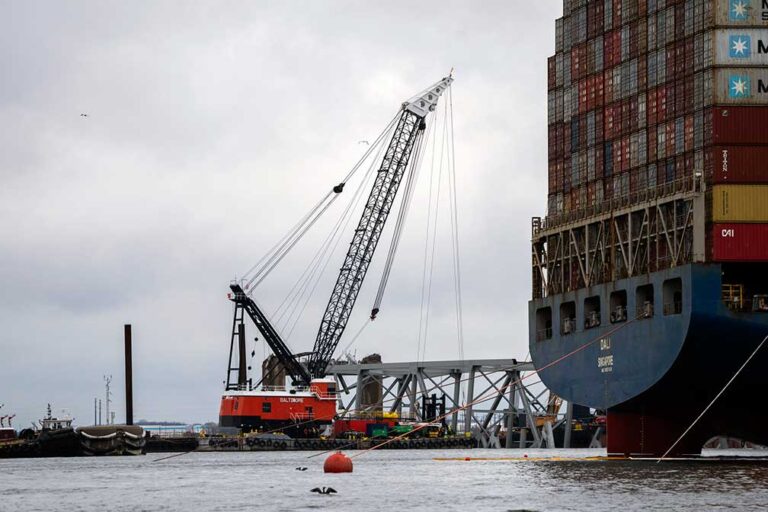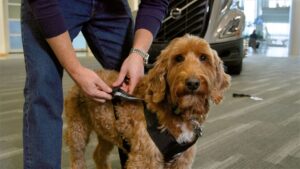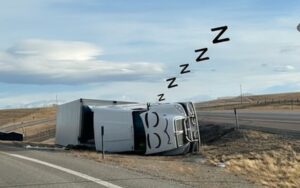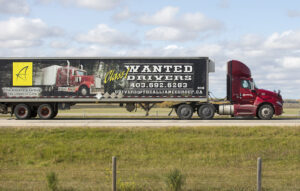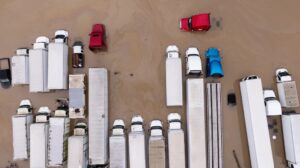BALTIMORE — A tugboat pushing a fuel barge was the first vessel to use an alternate channel to bypass the wreckage of Baltimore’s collapsed Francis Scott Key Bridge, which had blocked traffic along the vital port’s main shipping channel.
The barge, which was supplying jet fuel to the Department of Defense, left late Monday, April 1, and was destined for Delaware’s Dover Air Force Base, though officials have said the temporary channel is open primarily to vessels that are helping with the cleanup effort. Some barges and tugs that have been stuck in the Port of Baltimore since the collapse are also scheduled to pass through the channel.
Officials said they’re working to open a second channel on the southwest side of the main channel that will allow for deeper draft vessels, but they haven’t said when that might open.
On Tuesday, Maryland Gov. Wes Moore visited one of two centers that the Small Business Administration opened in the area to help companies get loans to assist them with losses caused by the disruption of the bridge collapse.
U.S. Sen. Ben Cardin, a Democrat who accompanied Moore in meetings with potential loan applicants, said he spoke with truck drivers who relied on the port to supply their cargo. They are among those feeling the immediate economic effects of the collapse, he said, but the ripple effects will be widespread — especially for small businesses, which he called “the growth engine of our nation.”
For Alex Del Sordo, who owns a marina and waterside restaurant near the collapse site, said the future economic landscape is largely a mystery. So far, his businesses have been busy servicing boats involved in the recovery and salvage operation and offering discounted meals for first responders. He said he and his partner are considering applying for a low-interest loan.
He anticipates a decrease in pleasure boating because boats moored in Baltimore’s harbor are temporarily trapped there. But he said rebuilding the Key Bridge will likely bring a large influx of labor and maritime traffic into the area, which could help some local businesses stay afloat.
“I think small businesses will have to be creative in what they offer,” he said.
Shipping costs and commute times will also increase for the working-class, water-oriented communities on either side of the bridge.
In Annapolis, a hearing was scheduled for Tuesday afternoon for a bill authorizing use of the state’s rainy day fund to help port employees who are out of work because of the bridge collapse and aren’t covered under unemployment insurance while the port is closed or partially closed. The bill also would let the governor use state reserves to help some small businesses avoid laying people off and to encourage companies that relocate to other ports to return to Baltimore when it reopens.
Lawmakers are working to pass the bill quickly in the last week of their legislative session, which ends Monday, April 8.
Crews are undertaking the complicated work of removing steel and concrete at the site of the bridge’s deadly collapse after a container ship lost power and crashed into a supporting column. On Sunday, dive teams surveyed parts of the bridge and checked the ship, and workers in lifts used torches to cut above-water parts of the twisted steel superstructure.
Authorities believe six members of a road construction crew plunged to their deaths in the collapse, including two whose bodies were recovered last week. Two other workers survived.
Moore, a Democrat, said at a Monday afternoon news conference that his top priority is recovering the four remaining bodies, followed by reopening shipping channels. He said that he understands the urgency but that the risks are significant. Crews have described the mangled steel girders of the fallen bridge as “chaotic wreckage,” he said.
“What we’re finding is it is more complicated than we hoped for initially,” said U.S. Coast Guard Rear Adm. Shannon Gilreath.
Meanwhile, the cargo ship Dali, which struck the bridge March 26, remains stationary, and its 21 crew members remain on board for now, officials said.
Other vessels are also stuck in Baltimore’s harbor until shipping traffic can resume through the port, which is one of the largest on the East Coast and a symbol of the city’s maritime culture. It handles more cars and farm equipment than any other U.S. facility.
Jim Roof, a longtime tugboat captain, said he’s waiting for a deeper channel to open before he can leave the harbor. He shook his head, thinking about the thousands of ships that have passed under the Key Bridge during his career.
“The system we have is pretty good,” he said, noting that in this case, the absolute worst possible timing caused large-scale disaster.
The local nonprofit Baltimore International Seafarers’ Center has been in contact with the crews of some stationary ships. The organization offers support to crew members docked in Baltimore, including transportation for shopping trips and other excursions.
Volunteer Rich Roca said seafaring is a challenging job even in the best of times. Crew members often leave their homes and families for months at a time. Some of those stuck in Baltimore are halfway around the world with no return in sight.
President Joe Biden is expected to visit the collapse site Friday, April 5, to meet with state and local officials. He has already promised significant federal resources to help the response effort.
The bridge fell when it was struck by the Dali, which lost power shortly after leaving Baltimore on its way to Sri Lanka March 26. The ship issued a mayday alert, which allowed just enough time for police to stop traffic, but not enough to save a roadwork crew filling potholes on the bridge.
The Dali is managed by Synergy Marine Group and owned by Grace Ocean Private Ltd., both of Singapore. Danish shipping giant Maersk chartered the Dali.
Synergy and Grace Ocean filed a court petition Monday seeking to limit their legal liability, a routine but important procedure for cases litigated under U.S. maritime law. A federal court in Maryland will ultimately decide who is responsible and how much they owe.
The filing seeks to cap the companies’ liability at roughly $43.6 million. It estimates that the vessel itself is valued at up to $90 million and was owed over $1.1 million in income from freight. The estimate also deducts two major expenses: at least $28 million in repair costs and at least $19.5 million in salvage costs.
By Lea Skene, The Associated Press. Contributing to this report were Associated Press journalists Brian Witte in Annapolis; Tassanee Vegpongsa in Baltimore; Sarah Brumfield in Washington; Michael Kunzelman in College Park, Maryland; and Rebecca Boone in Boise, Idaho.
The Associated Press is an independent global news organization dedicated to factual reporting. Founded in 1846, AP today remains the most trusted source of fast, accurate, unbiased news in all formats and the essential provider of the technology and services vital to the news business. The Trucker Media Group is subscriber of The Associated Press has been granted the license to use this content on TheTrucker.com and The Trucker newspaper in accordance with its Content License Agreement with The Associated Press.








